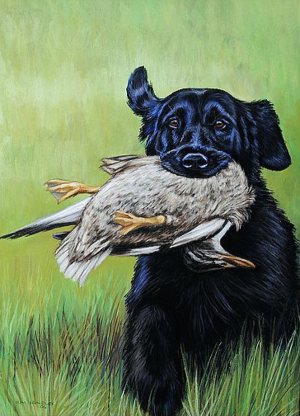
While a One-Trick Pony is someone who has only one special talent or area of expertise, the Flat-Coated Retriever’s, “one-piece-head,” should never be interpreted as a dog that can only retrieve. Indeed, the versatility of the breed as a strong utilitarian hunting companion that can flush and retrieve, and shine in Obedience, Agility, and Tracking is evidenced by the number of “Flatties” that have received Versatility Titles. However, about that head….
It’s an important characteristic of the breed because it is unique among retrievers. A fairly flat backskull, flat, clean cheeks, and a long, deep, and strong muzzle should give the impression of the head having been cast in one piece, so to speak. Indeed, that very phrase, “cast in one piece” is part of the breed standard. The head needs to be adequate in size and strength to grab and return back to the hunter a goose, large duck, rabbit or pheasant, and do it easily and gently. Other hunting dogs smaller than the Flat-Coat can retrieve a big bird (not that Big Bird), and maybe even do it as gently, but if the game is too big, they’ll have to grip the game more tightly to hang on to it, leaving teeth marks in the roasted bird on the dinner table. It’s unlikely that such a dog will be able to sustain an entire day of repetitive retrieving with as much stamina and longevity as the dog with the long head, long muzzle and large, strong jaws of the Flat-Coated Retriever (italicized wording from the breed’s illustrated standard). British breed authority, Stanley O’Neill, described the head as almost like a brick: Skull and foreface falling in almost the same continuous straight line. This makes evaluating the head from the side a necessity because determining the desired minimal and gradual “stop” (the point between the muzzle and the skull) from any other angle is difficult.
A marvelous image explaining the head can been seen here.
Image: “Treasure Hunting” by Kimberly Hundley is available as a print, home decor, and accessory here.
